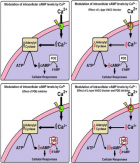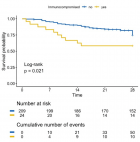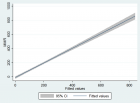Table of Contents
Canine Distemper Virus detection based in Hemaglutinine Gene as target in Reverse Transcriptase-Polymerase Chain Reaction
Published on: 27th December, 2018
OCLC Number/Unique Identifier: 7964755439
Canine Distemper have become a major concern within the veterinary clinical work. Thus, the appearance of many cases of canine distemper in adult animals with their vaccination plan up to date has alarmed veterinarians. Many cases of canine distemper have become a major concern within the clinical veterinary task. The purpose of this work was to detect the gene of hemagglutinin of the virus canine distemper, by using the Polymerase Chain Reaction associated with Reverse transcription (RT-PCR), as confirmation of the clinical diagnosis of disease. For this, peripheral blood samples of animals were used clinically patients and were grouped according to their date of extraction and using vaccines commercial as control.
The results allow to demonstrate a high sensitivity of the technique, besides allowing the use of samples up to seven days of storage at 4°C, despite the fragility of RNA viral.
Detection of canine distemper virus haemagglutinin gene in field samples and its high sensitivity, suggests studying its use as a diagnostic tool complementary to the clinical diagnosis of canine distemper in our country.
Review of Stereotactic and Neuronavigation Brain Biopsy Methods in the Dog
Published on: 1st November, 2018
OCLC Number/Unique Identifier: 7912354081
Objective: To perform a review of brain biopsies in the canine species and determine if it is possible to compare the stereotactic and neuronavigation results.
Method: A search was performed in NCBI’s PubMed database for stereotactic or neuronavigational canine brain biopsy publications and articles which met at least one of the inclusion criteria and not any of the exclusion criteria were selected. The inclusion criteria were: 1) assessment of the specificity of the biopsy, 2) assessment of system accuracy, 3) assessment of the biopsy results, and 4) duration of the procedure.
Results: Only one article met all the inclusion criteria. Eleven articles that partially met the criteria were used for comparison. Authors used different stereotaxic methods and two used neuronavigation equipment. The authors of the stereotactic studies either adapted devices from human medicine or developed their own devices; the level of accuracy was variable (errors of 0.0 mm to 5.1 mm), and the two articles that used animals with spontaneous lesions had a diagnostic specificity rate higher than 90 percent. The accuracy of the neuronavigation studies was approximately 3.3 mm; however, no live animals were used.
Conclusions: It was not possible to properly compare stereotactic and neuronavigation techniques. To do so, the methodologies and the assessed parameters need to be standardized.
Does Veterinary Science have a future in Australia?
Published on: 19th October, 2018
OCLC Number/Unique Identifier: 7900066839
Although the veterinary art has been practiced since antiquity, the modern era began in the 18th century with the establishment of the discipline of “Veterinary Science” at universities. In the 19th century, veterinary education began in Australia with Kendall’s private veterinary school in 1888 [1]. In 1909, a Veterinary Faculty was established at the University of Melbourne and Kendall’s school was incorporated into it. In 1910, a second faculty was established at the University of Sydney and in 1936, a third was established at the University of Queensland [2-4]. A fourth school was established at Murdoch University in Western Australia (WA) in 1974 [5].
The failure to provide an effective veterinary service to sheep in Australia
Published on: 3rd September, 2018
OCLC Number/Unique Identifier: 7856136930
Sheep are not native to Australia and were originally imported; 44 sheep were among the animals transported from Great Britain to the penal colony established on the east coast of Terra Australis in January 1788 http://firstfleetfelowshp.org.au.
The following brief account of the history of wool in Australia is taken from “The Australian Merino” which began;
The Australian Merino…comprised one of the greatest creative expressions of domestic animal species by and for mankind…one of the greatest contributions to the world economy [1].
These original sheep were for human provisions and consisted of fat-tailed native sheep from the Cape of Good Hope, but the primary source of sheep for the first three or four decades of Australia’s history were from Bengal, the closest British colony to Australia.
Livestock insurance a tool to reduce economical loss of farmers from climate change related Hazards
Published on: 23rd July, 2018
OCLC Number/Unique Identifier: 7815003571
Climate change brings extreme events like drought, landslide, flood and anticipated more constraint to profitable livestock production causing huge economical loss in the livestock sector of the country. Deaths of livestock and damage to farms and farm infrastructure is causing a huge loss, small livestock holders are highly venerable to such climatic hazards. So to cope with these uncertain climatic hazards livestock insurance is the one of the best strategies. This study reveals that different climatic hazards is been experienced by the livestock holders of Kaski, Dolakha and Jhapa district of Nepal, 62% of the respondent has observed the change in climate. Of the total respondents perceived around 47% farmer have insured their livestock in Kaski district, 33% in Jhapa and 20 % in Dolakha district. Beside the proper vaccination, deworming, management and feeding of animals people are insuring their livestock assets due to uncertain in the climatic pattern and its consequences, this shows that livestock insurance is the one of the tool to mitigate with changing climate and climate relate hazard in livestock sector of Nepal.
Effects of carazolol on electrocadiographic and trace element status in sheeps
Published on: 9th April, 2018
OCLC Number/Unique Identifier: 7666282308
Carazolol is a non-specific β-adrenargic reseptor blocking agent. It ıs structurally analogous to catecholamins, in that, when administered, it forms reversible bonds with β-adrenergic, however, induce adrenergic effects, and it inhibits the actions of the catecholamins in times of stres by saturing their sites of operation. The purpose of the research was to investigate the effects of carazolol on some serum enzymes, trace elements and cardiovascular status in sheep. Seven sheeps (age 6 months, 35 ± 10 kg) were used in this study. Carazolol administered by the intramuscular route at the dose of 0.01 mg/kg. Serum levels of urea, creatinin, ALT, AST, G-GT, LDH, T. protein, Ca, P, Mg, Cu, Fe, Zn, Se were investigated. Although all serum enzymes did not show any difference, serum Fe and Zn levels were decreased. Important results were obtained in electrocardiography (abnormal T wave and ST segment depression).
These results suggest that carazolol may increase incidence rate of myocardiyal ischemia risk in sheeps and it investigated by new researches.

If you are already a member of our network and need to keep track of any developments regarding a question you have already submitted, click "take me to my Query."

















































































































































